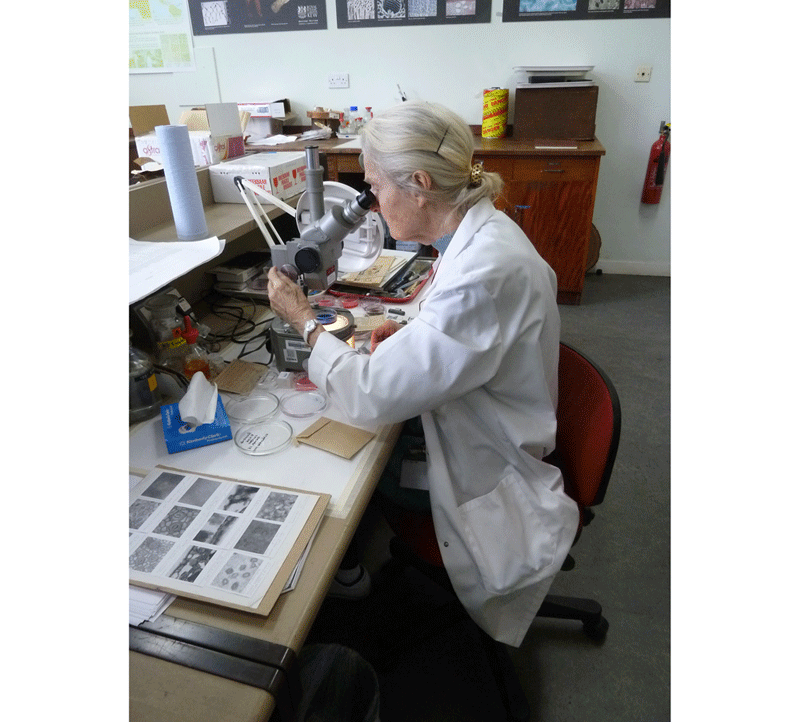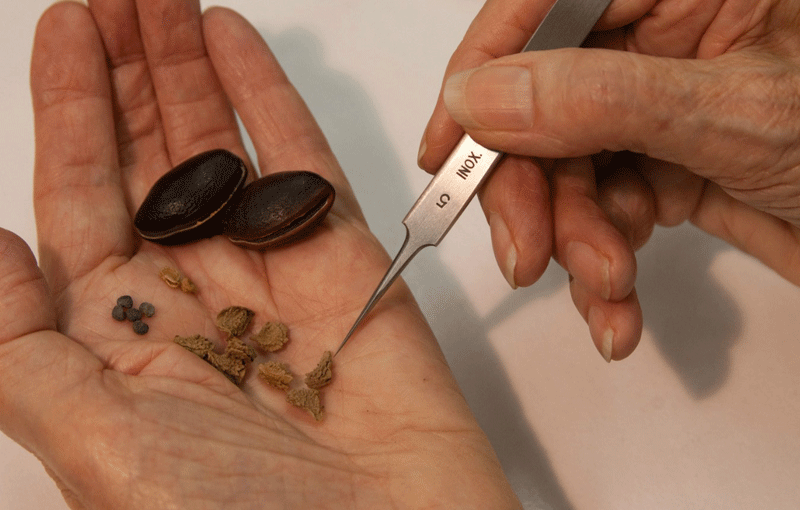14 February 2019
Hazel Patricia Wilkinson (1932–2019)
Paula Rudall and Peter Gasson remember 'Kew's Miss Marple'.

A widely respected Kew researcher, Dr Hazel P. Wilkinson, died in January 2019 at the age of 87. Hazel retired from Kew staff in 1992, but continued to work in the Anatomy lab almost daily as an Honorary Research Fellow until within a few months of her death, despite being restricted by debilitating back problems in recent years. Known affectionately from her forensic work as "Kew's Miss Marple" (an epithet that appealed to her), Hazel will be greatly missed by those who knew her.

Following the award of a PhD in 1971 at the City of London Polytechnic (now part of London Metropolitan University), Hazel was appointed in 1973 to work on the Kew-based volume series Anatomy of the Dicotyledons, which was published by Oxford University Press and edited initially by the former Jodrell Keeper Charles Metcalfe and subsequently by David Cutler and Mary Gregory. She published papers on the anatomy of several eudicot families, including Anacardiaceae, Gunneraceae, Menispermaceae, Pittosporaceae and Pterostemonaceae. She deposited large numbers of microscope slides into Kew's microscope slide collection, thus establishing them as a permanent and accessible resource. Perhaps Hazel's most enduring work in this series was her chapter on the Plant Surface, in which she described not only the many different types of hairs that occur on leaf surfaces, but also extrafloral nectaries and domatia that form the basis for plant–insect interactions, later supplemented by a study of leaf teeth.
In addition to (and complementing) her work as a plant anatomist, Hazel was a noted palaeobotanist who specialised in the fossil woods of the Eocene London Clay Flora. Throughout her life, Hazel made frequent fossil-collecting trips to the Isle of Sheppey on the north coast of Kent, either alone or accompanied by other researchers and interested friends and associates, including several Kew staff. She published several papers on this topic, some of them in collaboration with her PhD student, Imogen Poole, who was awarded a PhD at Royal Holloway, London University in 1993. One of Hazel's most significant finds was fossilized mangrove hypocotyls, including characteristic starch grains. The chance discovery of unusually well-preserved fossil fungal hyphae in pyritized twigs formed the basis for another publication.
In recent years, Hazel's interests turned to forensic work, most notably the high-profile case of "Adam", which was the name given by the Metropolitan Police to an unidentified young boy whose torso was discovered in the river Thames in 2001. Hazel identified most of the plant material found in Adam's small intestine, including calabar beans and other poisonous herbs used in Nigeria. As the police searched for evidence of the identity and origin of the victim and how he died, Hazel appeared on various news channels and newspaper articles. "Of course we all want to learn Adam's identify and trace his killers," she said. "But this is fascinating work, too. It's challenging trying to discover something, especially when you know the answer could be around the corner. It draws you on to find out more" (Daily Telegraph, 26 Nov 2006).
Hazel was awarded a Kew Medal in 1993, when the citation read as follows: "Hazel Wilkinson has been a tireless worker for Kew for the last 20 years, both as an employee and as a volunteer. Hazel has always kept a low profile, preferring to work conscientiously on a subject which she loves, and this work has been to the considerable benefit of Kew's reputation."

References
Poole, I. & Wilkinson, H.P. (1999). A celastraceous twig from the Eocene London Clay of south-east England. Botanical Journal of the Linnean Society 129: 165–176.
Poole, I. & Wilkinson, H.P. (2000). Two early Eocene vines from south-east England. Botanical Journal of the Linnean Society 133: 1–26.
Poole, I., Davies, K.L., & Wilkinson, H.P. (2002). A review of the platanaceous woods from the Eocene paratropical rainforest of south-east England. Botanical Journal of the Linnean Society 139: 181–191.
Wilkinson, H.P. (1979). The plant surface (mainly leaf). Pages 97–117 in C.R. Metcalfe and L. Chalk, eds. Anatomy of the Dicotyledons. 2nd ed., Vol I. Clarendon Press, Oxford, UK.
Wilkinson, H.P. (1981). The anatomy of the hypocotyls of Ceriops Arnott (Rhizophoraceae), recent and fossil.Botanical Journal of the Linnean Society 82: 139–164.
Wilkinson, H.P. (1983a). Leaf anatomy of Gluta (L.) Ding Hou (Anacardiaceae). Botanical Journal of the Linnean Society 86: 375–403.
Wilkinson, H.P. (1983b). Starch grain casts and moulds in Eocene (Tertiary) fossil mangrove hypocotyls. Annals of Botany 51: 39–45.
Wilkinson, H.P. (1989). Leaf anatomy of the Menispermaceae tribe Tiliacoreae Miers. Botanical Journal of the Linnean Society 99: 125–174.
Wilkinson, H.P. (1992). Leaf and twig anatomy of the Pittosporaceae R. Br. Botanical Journal of the Linnean Society 110: 1–59.
Wilkinson, H.P. (1994). Leaf and twig anatomy of the Pterostemonaceae (Engl.) Small: Ecological and systematic features. Botanical Journal of the Linnean Society 115: 115–131.
Wilkinson, H.P. (2000). A revision of the anatomy of Gunneraceae. Botanical Journal of the Linnean Society 134: 233–266.
Wilkinson, H.P. (2003). Fossil actinomycete filaments and fungal hyphae in dicotyledonous wood from the Eocene London Clay, Isle-of-Sheppey, Kent, England. Botanical Journal of the Linnean Society 142: 383–394
Wilkinson, H.P. (2007). Leaf teeth in certain Salicaceae and ‘Flacourtiaceae’. Botanical Journal of the Linnean Society 155: 241–256.




